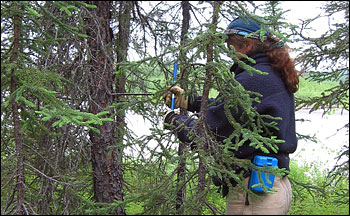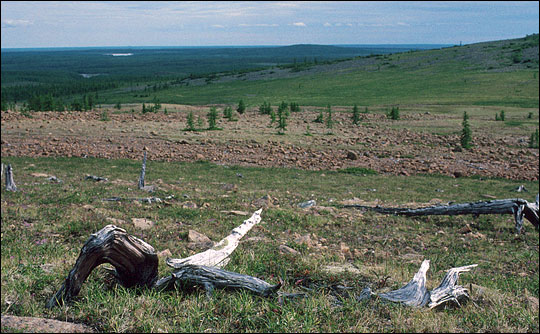

Ground Observations Support Satellite View |
|||
As much as Angert and Goetz were surprised by their findings, ecologists working in the field in Alaska had been expecting just such an analysis to come out. Glenn Juday is a professor of forest ecology and director of the Tree Ring Laboratory at the University of Alaska Fairbanks, and he was the lead author for the forest section of the Arctic Climate Impact Assessment report, a comprehensive summary of scientific knowledge about the Arctic and climate change published in 2004. He has spent much of his career studying how trees in the boreal forests respond to warming temperatures by mapping the correlation between tree rings and temperatures. When asked if Goetz and Angert’s observations matched what he saw in the field, Juday responded with an unequivocal “absolutely.” He has found, for example, that Northern White Spruce grow more slowly after July temperatures reach 16.5 degrees Celsius or warmer. Along the cold, high-elevation tree line, as many as 40 percent of the trees grow less when temperatures are warm. “These are the trees that are supposed to do well as a result of climate warming,” Juday points out. “Well, the trees don’t know that.” |
|||

Juday had sampled thousands of trees in a wide range of locations to understand how each type of tree in each type of location would respond to climate change. He thought he had a good understanding of individual species, but not how the entire forest ecosystem was reacting to warming temperatures and a lengthening growing season. “The big problem we were facing was, if you’re drilling cores in trees and taking them back to the lab, and then measuring them, it’s a daunting task to try to cover enough terrain to get an answer for the overall boreal forest of North America,” says Juday. “You can do all the plot sampling feasible in a career, and you still can’t get enough coverage. At some point, you have to have a synoptic view of what’s happening over the planet. The only planet-sampling tools we have are satellite remote sensors.” Goetz and Angert’s analyses of the satellite data told him that a large part of the forest was responding negatively to warming temperatures. The Boreal Forests Face Climate ChangeBut what does a drying, browning forest mean? What impact could a decline in the health of the boreal forests have on the rest of the planet? One of the reasons scientists are so concerned about these Northern forests is the large role they have in the global carbon cycle. When carbon dioxide is released from fossil fuel burning or other sources, about half of it stays in the atmosphere where it acts as a greenhouse gas heating the surface of the Earth, and half is absorbed by the land or the oceans. Though scientists aren't sure exactly where all carbon is stored on land, the boreal forests, most of which are intact, are a likely candidate. A little over 30 percent of the world's forests are in the far North, with boreal forests covering 17 percent of the Earth's land surface area. As such, the Northern forests are a big storage area for carbon, says Houghton, the ecologist and carbon expert working with Goetz. If the forests stop soaking up carbon dioxide or slow their productivity, then more carbon dioxide remains in the atmosphere to contribute to global warming. “Nature’s been helping by storing carbon on land. It’s possible that nature won’t always help us, and we’re starting to have the first suggestions of that,” says Houghton. “The Northern terrestrial carbon sink is starting to waiver. We don’t know if that will continue or get worse, but this seems to be the beginning.” Houghton acknowledges, with some skepticism, “It might be that the last five or ten years were peculiar.” It’s possible, in other words, that the warming and drying of the forests might be a short-term, not a long-term trend. But even if the past ten years were peculiar and temperatures drop in the future, the trees may not return to their previous levels of production, warns Juday. “There are all sorts of thresholds built into these systems that are responding, and when you cross those thresholds, you can not confidently expect it [the forest] will come back. It may not. In fact, it very often does not.” In Siberia, for example, as the Ice Age ended about 20,000 years ago, forests expanded up to the Arctic shore as ice sheets retreated. About 8,000 years ago, tree rings, ice and sediment cores, and other paleoclimate records show that temperatures began to drop. (The cooling may have been triggered by a massive flood of glacial meltwater into the northern Atlantic Ocean.) Despite cooler temperatures, the forest continued to grow until the eruption of the Mediterranean volcano Santorini around 1628 BC. The sulfur aerosols that the eruption pumped into the atmosphere further cooled temperatures for a few years, and during those years, the northernmost forests died. Though warmer temperatures returned, the trees never came back, says Juday. Tundra replaced the forest. |
Researchers studying tree growth rings confirm that trees in the boreal forest don’t necessarily grow more vigorously in warm temperatures. In fact, the growth of 40% of the trees sampled slowed when July temperatures rose above 16.5°C (Photography copyright Glenn Patrick Juday, University of Alaska Fairbanks.) | ||

| |||
The current boreal forest would likely be replaced with other types of forest as climate warms, but as the forest changes, its role in the carbon cycle could be reversed: it could turn from being a carbon sink to being a carbon source. Currently, the trees tuck away carbon and eventually transfer it to the frozen soil, where carbon accumulated over the past 10,000 years is now stored. “But if you turn your refrigerator off, things decay,” Houghton explains by analogy, and the decaying soil would release carbon dioxide. The trees themselves could also become a source of carbon dioxide if fires or insects kill large swaths of forest. Thawing, burning, and insect outbreaks are increasingly probable as temperatures rise. Only time will tell if the drop in productivity measured by satellites and confirmed by ground-based carbon dioxide observations is a symptom that the boreal forests have reached a critical threshold. Angert observes, “I guess most people believe that there will be some turning point, but they believe it will be a few decades ahead when it gets so hot that the biosphere starts emitting carbon dioxide. These studies hint that we’re already close on this turning point.”
|
Ancient tree stumps and logs dot the tundra north of the treeline in Siberia. Temperature records derived from the fossil wood suggest that a cold period associated with volcanic aerosols destroyed the forest in 1628 BC. Even after warmer temperatures returned, the forest never recovered. (Photograph copyright Jan Esper Swiss Federal Institute for Forest, Snow and Landscape Research.) | ||